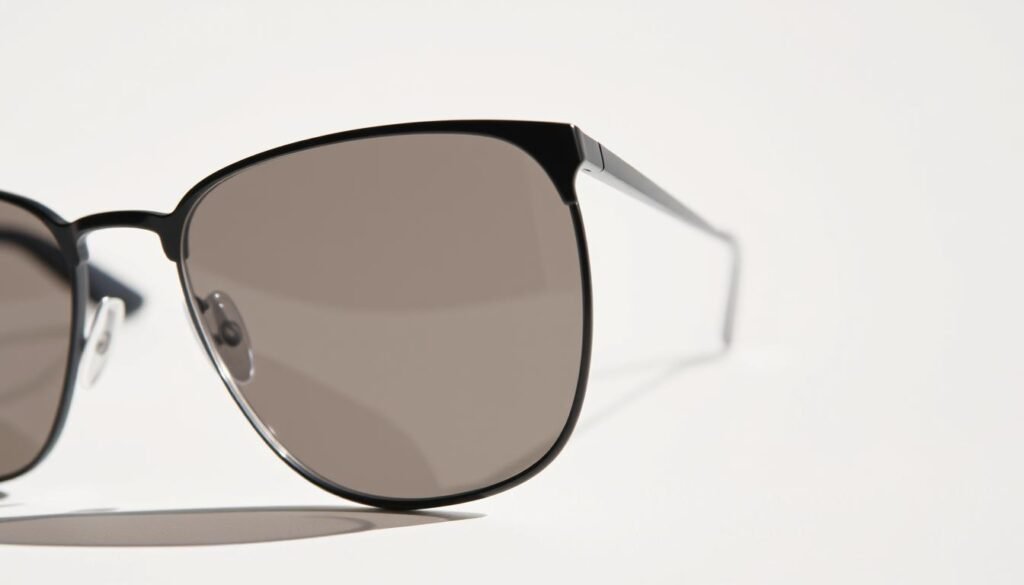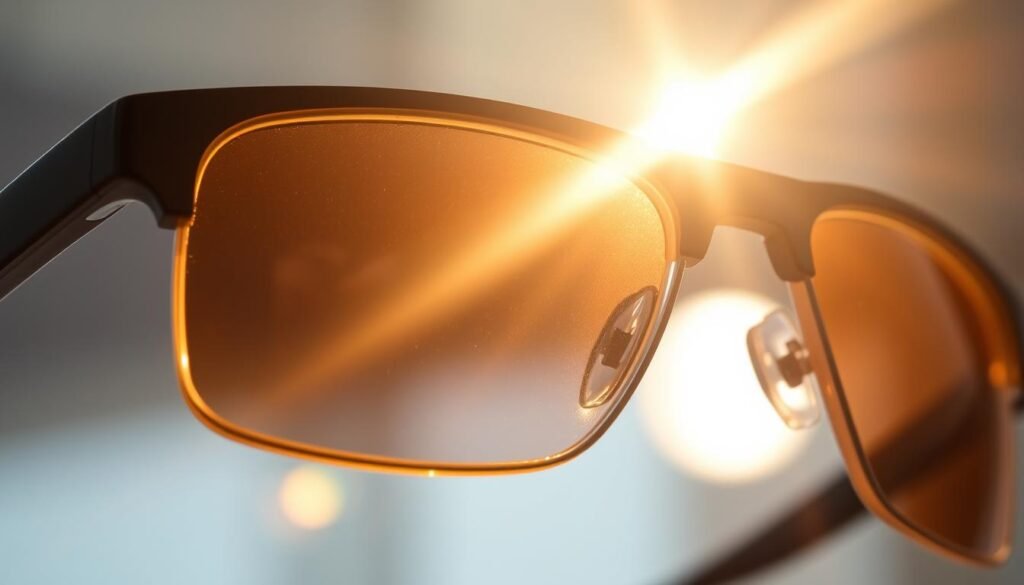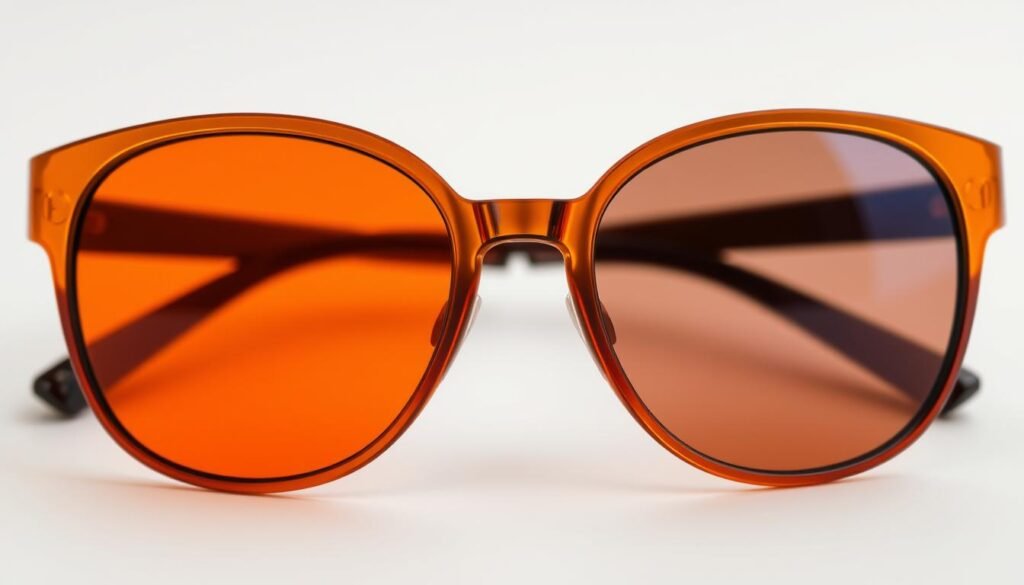Choosing the right lens color isn’t just about style—it’s a critical decision for maintaining vision health. Different tints filter light uniquely, helping you see clearly while shielding against UV rays that contribute to long-term damage. Whether you’re hiking, driving, or enjoying a sunny day, the ideal hue balances comfort and safety.
Gray and green lenses are popular for reducing glare without distorting colors, making them versatile for everyday use. Amber or brown tints enhance contrast in low-light conditions, perfect for activities like fishing or skiing. For water sports, mirrored coatings help cut reflected light, while blue-light-blocking options gain traction for digital screen use.
Always prioritize 100% UV protection—lens color alone won’t safeguard your eyes. Pairing the correct tint with polarized coatings can further minimize strain. This guide breaks down how specific shades improve visibility and which scenarios demand specialized solutions.
Key Takeaways
- Lens color impacts glare reduction and contrast enhancement
- Gray/green tints work best for general daylight conditions
- Amber lenses improve visibility in overcast or low-light settings
- Mirrored coatings excel in high-glare environments like snow or water
- UV-blocking technology remains essential regardless of tint choice
- Match lens colors to specific activities for optimal results
Understanding UV Radiation and Its Impact on Eye Health
Sunlight contains invisible ultraviolet rays that silently threaten your vision. While UVC rays get absorbed by Earth’s atmosphere, UVA and UVB rays reach us daily. These harmful rays don’t just cause temporary discomfort—they create lasting damage to delicate eye structures.
How UVA and UVB Rays Affect Your Eyes
UVA rays penetrate deep into the eye, targeting the macula. This small area handles sharp central vision needed for reading or recognizing faces. Over time, this exposure can lead to blurred or distorted sight.
UVB rays focus on the lens, the clear part that helps focus light. Prolonged contact causes proteins in the lens to clump, creating cloudy patches. The World Health Organization states:
“Up to 20% of cataracts result directly from UV exposure.”
The Connection to Macular Degeneration and Cataracts
Consistent UV exposure doubles your risk of macular degeneration, a leading cause of vision loss in adults. It also speeds up cataract formation, which clouds the lens and dulls color perception. Children face higher risks—their pupils are larger, and their lenses filter only 25% of UV rays compared to 50% in adults.
Key facts to remember:
- UVA targets central vision areas
- UVB damages the eye’s natural lens
- Kids need extra protection due to developing eyes
How to Choose the Right UV Protective Sunglasses
Selecting effective UV-blocking eyewear involves more than style—it’s about pairing smart features with proper fit. Two critical factors separate adequate coverage from exceptional defense: verified protection standards and designs that seal out harmful rays.

Essential 100% UV Protection and Labeling
Always check labels for “UV400” or “100% UVA/UVB protection” certifications. These markings confirm lenses block all ultraviolet wavelengths up to 400 nanometers. The American Optometric Association notes:
“Proper labeling is the first checkpoint—never assume dark lenses automatically offer full shielding.”
Importance of Frame Design and Fit
Wraparound styles eliminate side gaps where sunlight sneaks in. Larger frames with curved temples prevent upward glare reflection. For active use, secure fits prevent slippage while maintaining airflow to avoid fogging.
Test comfort by moving your head briskly—quality pairs stay put without pressure points. Those with wider faces might prefer adjustable nose pads, while oval shapes often suit most frame types. Remember: gaps around edges defeat even the strongest UV-blocking lenses.
sunglasses best for eye protection?
Not all shades offer equal defense against environmental threats. Top-performing pairs combine advanced materials and smart engineering to block harmful elements while maintaining visual clarity.

Key Features for Maximum UV Blocking
Polycarbonate leads in lens technology. This space-grade material naturally filters 100% UV rays without coatings. Its shatter-resistant quality makes it perfect for athletes and outdoor workers.
Polarized options tackle glare differently. While they don’t boost UV blocking, they cut horizontal light reflections. This improves safety during driving or fishing by revealing hidden surface details.
- Impact-resistant designs meet FDA safety benchmarks
- Wraparound frames prevent peripheral light leaks
- Mirrored coatings add extra reflection defense
The FDA requires all lenses to pass basic durability tests. However, premium choices often use military-grade standards. As one optician notes:
“High-end brands test lenses with steel pellets at 100 mph to ensure no shattering.”
Match features to your activities. Cyclists benefit from aerodynamic frames, while beachgoers need water-repellent coatings. Always verify UV400 labeling—the golden standard for full-spectrum defense.
Exploring Lens Colors and Tints for Optimal Eye Protection
Your lens color acts like a personal light filter, shaping how you experience the world visually. Different tints manipulate light entering your eyes in distinct ways, balancing clarity with comfort. Let’s decode how specific hues enhance vision while defending against environmental stressors.
Color Science Meets Practical Performance
Gray lenses excel in bright sunlight by reducing glare without altering color accuracy. They’re ideal for drivers and beachgoers who need natural vision. One study found gray tints reduce light transmission by 40-60%, making them versatile for variable conditions.
Amber and brown options boost contrast in fog or overcast weather. These warm tones heighten depth perception—critical for spotting trail obstacles during hikes. “Contrast enhancement can improve reaction times by 12% in low-light scenarios,” notes an optometry journal.
Green lenses strike a unique balance. They sharpen details in grassy environments while easing strain during prolonged outdoor sessions. Their medium-dark tint filters blue light effectively without oversaturating colors.
Mastering Light Transmission Levels
Visible Light Transmission (VLT) determines how much brightness reaches your eyes. Darker lenses (10-20% VLT) work best for intense sun, while 30-40% suits mixed lighting. Lighter tints (50%+) help cyclists spot road hazards in shifting shadows.
- Gray: 15-25% VLT (full sun)
- Brown: 20-30% VLT (variable light)
- Green: 10-20% VLT (high glare)
Match your lens color to both environment and activity. Water sports demand mirrored coatings, while urban commuters benefit from gradient tints. Always pair your chosen hue with UV400 protection for complete defense.
Advantages of Polarized and Specialized Lenses
Modern lens technology transforms how we interact with bright environments. Polarized options use a chemical filter to manage light waves, offering unique benefits for specific scenarios. Let’s explore how these innovations improve safety and comfort.
Reducing Glare and Enhancing Contrast
Polarized lenses tackle intense reflections from flat surfaces like lakes or snowy fields. They block horizontal light waves—the main cause of blinding glare. This lets you spot submerged rocks while fishing or read road signs through windshield reflections.
Studies show polarization improves reaction times by 15% in high-glare conditions. Colors appear richer, and details become crisper, reducing squinting during long drives. Anglers often report seeing fish beneath the water’s surface more clearly.
When to Consider Polarization
While these lenses excel near water or snow, they’re less ideal for digital device users. The same filter that cuts glare can darken LCD screens on phones or car dashboards. A National Eye Institute report states:
“Polarized options reduce visual fatigue by 40% in reflective environments but may hinder screen readability.”
| Feature | Polarized | Non-Polarized |
|---|---|---|
| Glare Reduction | Excellent | Moderate |
| LCD Screen Visibility | Limited | Clear |
| Best For Activities | Fishing, skiing | City driving, tech use |
Keep a spare pair without polarization if you frequently check devices outdoors. This dual approach ensures sharp vision across all situations while maintaining UV defense.
Essential Sunglasses Features and Additional Coatings
Advanced materials and precision coatings work together to create eyewear that guards against both immediate and long-term threats. While lens color affects light perception, the underlying construction determines durability and defense capabilities. Modern options blend science with practicality, offering tailored solutions for diverse lifestyles.
Choosing the Right Lens Materials
Polycarbonate leads in impact resistance, making it ideal for sports or rugged use. This lightweight material naturally blocks UV rays without extra layers. For those needing optical clarity, Trivex lenses provide sharper vision while maintaining durability.
Glass remains popular for scratch resistance but adds weight. New composite materials like NXT polyurethane offer flexibility without sacrificing protection. As one optical engineer notes:
“Material choice affects everything from distortion levels to shock absorption—match it to your activity’s demands.”
Enhancing Performance with Coatings
UV400-certified coatings form the foundation of defense, filtering harmful rays completely. Anti-reflective treatments cut glare from headlights or water surfaces, improving safety during dawn commutes or fishing trips.
Mirror finishes reflect intense light in snowy or coastal environments. Scratch-resistant layers preserve lens integrity through daily wear. A recent Consumer Reports study found:
- Coated lenses last 2x longer than untreated options
- AR treatments reduce eye strain by 37% in bright settings
- Multi-layer coatings provide cumulative benefits
Pair materials with coatings that align with your priorities—adventurers might prioritize durability, while drivers benefit most from glare reduction.
Tips for Buying Sunglasses to Protect Your Eyes
Smart shopping for vision protection starts with understanding labels and personal needs. The right pair becomes an extension of your daily routine, blending defense with comfort seamlessly.
Decoding Labels for Complete Coverage
Always hunt for UV400 or 100% UVA/UVB protection markings. These guarantee full-spectrum defense against harmful rays. Test fit by nodding sharply—good pairs stay put without nose indents or temple pressure.
Check lens quality using a grid pattern. Hold them at arm’s length—if straight lines warp, skip them. Wraparound styles prevent side glare, while flexible frames suit active lifestyles.
Matching Gear to Daily Adventures
Consider how much time outdoors you spend weekly. Polarized options work wonders for boaters, while amber tints help trail runners spot roots. Parents: prioritize shatterproof materials for kids’ pairs—their developing eyes need extra care.
Urban commuters might choose lightweight gradients, whereas skiers benefit from mirrored coatings. Remember: proper fit and certified protection matter more than trendy designs for long-term safety.

